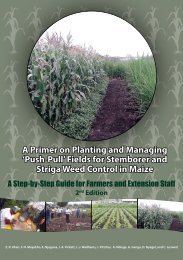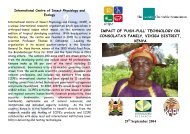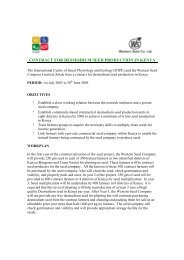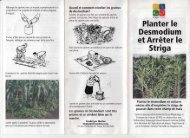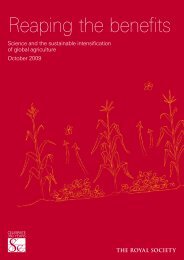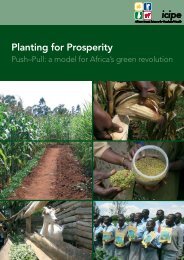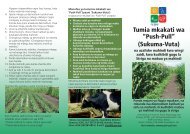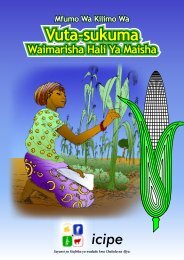Biology and management of economically important ... - Push-Pull
Biology and management of economically important ... - Push-Pull
Biology and management of economically important ... - Push-Pull
You also want an ePaper? Increase the reach of your titles
YUMPU automatically turns print PDFs into web optimized ePapers that Google loves.
716 KFIR ET AL.<br />
Breeding for Resistance<br />
Efforts have been made to incorporate resistance <strong>of</strong> maize <strong>and</strong> sorghum to<br />
C. partellus into a good agronomic background during the past two decades<br />
(6, 7, 14), <strong>and</strong> many genotypes are already in national yield trials. Resistant lines/<br />
hybrids with good general combining ability have been identified (167). Several<br />
hybrid sorghums bred in South Africa exhibited greatest tolerance to stem borer<br />
damage <strong>and</strong> therefore suffered low yield losses (202).<br />
Biological Control<br />
Over the past 60 years, there have been numerous attempts to introduce exotic<br />
parasitoids into Africa <strong>and</strong> the Indian Ocean Isl<strong>and</strong>s for biological control <strong>of</strong><br />
exotic <strong>and</strong> native stem borers, but only a few species have established (Table 2).<br />
On the mainl<strong>and</strong>, only C. flavipes has established.<br />
In 1993, the gregarious larval endoparasitoid, C. flavipes, was introduced<br />
into Kenya from Pakistan for biological control <strong>of</strong> C. partellus. Releases were<br />
made in the southern coastal area <strong>of</strong> Kenya (144), <strong>and</strong> the parasitoid was recovered<br />
during the season <strong>of</strong> release from C. partellus <strong>and</strong> two native stem borers,<br />
C. orichalcociliellus <strong>and</strong> S. calamistis (143). In 1994 only one stem borer<br />
parasitized by C. flavipes was found despite intensive sampling. In 1995 <strong>and</strong><br />
1996 a few recoveries were made but parasitism remained low (143). In 1997<br />
the number <strong>of</strong> recoveries increased dramatically <strong>and</strong> parasitism at 30 sites averaged<br />
about 6%. Parasitism continued to increase during the next two years<br />
with average parasitism <strong>of</strong> about 13% in 1999 (228). Surveys in other maizegrowing<br />
areas <strong>of</strong> Kenya showed that C. flavipes was present in the Eastern Province<br />
(183) <strong>and</strong> in the area bordering Lake Victoria in western Kenya (139). In the<br />
Eastern Province, C. flavipes was found in low densities in 1996 <strong>and</strong> then<br />
released at three sites in 1997. Parasitism during the season following<br />
the releases was about 14% (183). C. flavipes was never intentionally released<br />
in western Kenya, but Omwega et al. (139) speculated that the establishment<br />
was the result <strong>of</strong> insects that escaped from a local laboratory colony in<br />
1992. However, parasitism in western Kenya has not increased to the levels<br />
observed in coastal Kenya or the Eastern Province (133). In western Kenya, four<br />
stem borers are common in maize, C. partellus, S. calamistis, B. fusca, <strong>and</strong> E.<br />
saccharina (163), all <strong>of</strong> which are attractive <strong>and</strong> acceptable hosts for C. flavipes.<br />
Two <strong>of</strong> which, B. fusca <strong>and</strong> E. saccharina, are not suitable for its development<br />
(123, 143). Overholt (141) suggested that the presence <strong>of</strong> acceptable but unsuitable<br />
hosts in an area would create a sink for C. flavipes eggs <strong>and</strong> depress population<br />
growth.<br />
The impact <strong>of</strong> C. flavipes on stem borer populations in coastal Kenya was<br />
recently investigated (228). A ratio-dependent, host-parasitoid model was used to<br />
estimate the stem borer density with <strong>and</strong> without the parasitoid. A reduction <strong>of</strong> 1.1–<br />
1.6 stem borers/plant, equivalent to a 32–55% decrease in the stem borer density,



